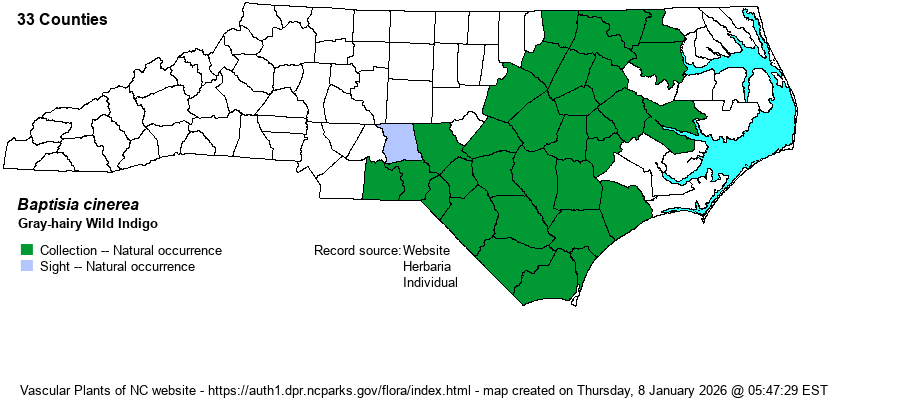| Author | (Rafinesque) Fernald & Schubert | |
| Distribution | Throughout the western, central, and southern Coastal Plain, and barely into the extreme eastern edge of the Piedmont. Absent from the eastern counties; no records east of Hertford, Bertie, Beaufort, and Onslow counties.
This species is nearly restricted to NC and SC. It ranges from extreme southern VA, through NC, and through central and eastern SC, but apparently not yet found in GA. | |
| Abundance | Common and easily found in the Sandhills region; fairly common to common eastward in the southern Coastal Plain to the coast (as far north as Onslow County). Generally uncommon in the northern half of the Coastal Plain, and very rare into the extreme eastern Piedmont. Because of its widespread occurrence in NC, it certainly should have a State Rank of S4, and this means the Global Rank should also be at least G4. The ranks provided by NatureServe and the NCNHP understate its commonness. | |
| Habitat | This is a classic sandhills species. It occurs in typical pine/scrub oak sandhills, mostly under Longleaf Pine (Pinus palustris). It is not limited to high quality, diverse sites, but it certainly is favored by prescribed fire in its habitat to keep woody species at bay. It can occur in other types of sandy soil habitats, away from Longleaf Pine, such as in the northern Coastal Plain and Piedmont edge; i.e., in sandy woods or their margins. | |
| Phenology | Blooms from late April into June, and fruits in June and July. | |
| Identification | This is a very showy species when in bloom, owing to its quite large bright yellow flowers. It is a rather low-growing and sprawling herb, reaching only about 1-1.5 feet high, and often somewhat wider; the stem is often leaning. It has rather few alternate leaves, each being trifoliate with 3 large leaflets, and the leafstalk is several inches long. Each leaflet is elliptic, and around 2.5-3 inches long and 1 inch wide. The racemes are terminal at the ends of branches, usually growing horizontally, with many densely packed bright yellow flowers, each 1 inch long. The pods are rounded and about 1-1.25 inches long. What makes this plant unique is that after death in the fall, the entire plant turns gray to light brown and remains above ground into the winter, becoming a "tumbleweed" at times when the base of the dead stem breaks off. Thus, it doesn't just "wither away" as nearly all other herbaceous plants do! You do not need flowers to identify the species, as it is normally the only 1 foot tall, bushy legume with three large leaflets in its sandy soil habitat. Thankfully, you should be able to see this species on many walks in sandhills habitats in that region in spring and summer, and when in bloom it can be seen at long distances. | |
| Taxonomic Comments | None
| |
| Other Common Name(s) | Carolina Wild Indigo, Hairy Wild Indigo | |
| State Rank | S3S4 [S4] | |
| Global Rank | G3G4 [G4] | |
| State Status | | |
| US Status | | |
| USACE-agcp | | |
| USACE-emp | | |

